William Bartram’s Travels and the Early Naturalist’s Library
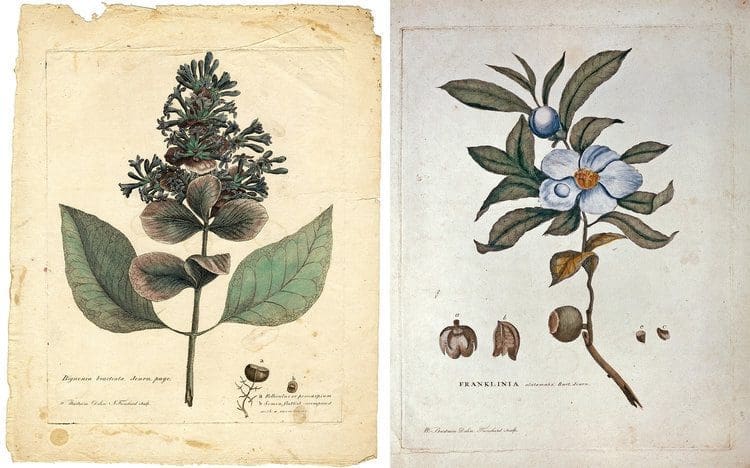
William Bartram’s reputation as a botanist, naturalist, and explorer has endured in the modern world largely due to his single, classic book: Travels through North & South Carolina, Georgia, East & West Florida, the Cherokee Country, the Extensive Territories of the Muscogulges, or Creek Confederacy, and the Country of the Chactaws… Printed by James & Johnson, Philadelphia, 1791. William Hamilton had an extensive library and owned at least two copies of the book authored by his friend. One of his copies is now housed at the Sterling Morton Library at the Morton Arboretum in Lisle, IL and offers an interesting glimpse into the naturalist’s library.
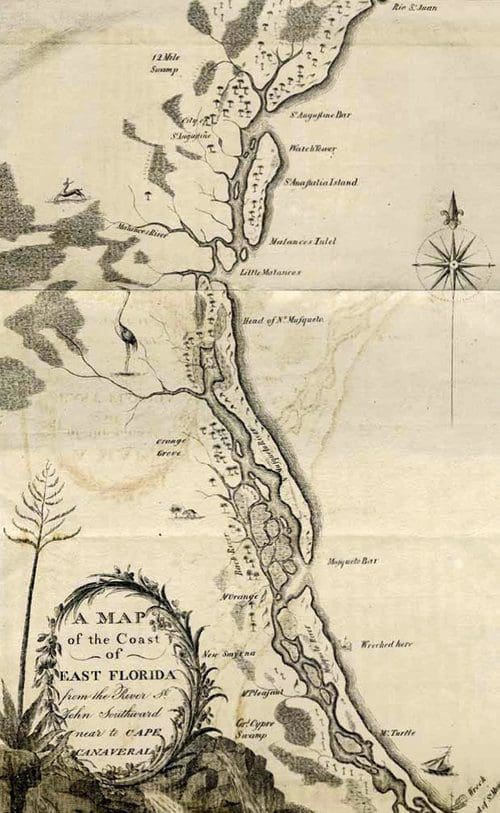
William Bartram, “A Map of the Coast of East Florida.”– Travels…, Philadelphia: 1791.
In vivid text, Travels recounts Bartram’s southern explorations from 1773 to 1776, and documents his encounters with the natural world and with the native and colonial inhabitants of the English colonies along the Southern Atlantic and Gulf coasts. Bartram’s descriptions of Florida and the South captured readers internationally during his life and the book continues to be read widely in modern times. Bartram’s Travels was an unprecedented mix of literary genres—part travel book, part scientific record and description — a romantic narrative, an ethnography of Southern native peoples, and an exposition by Bartram on natural and theological philosophy.
The publication of Travels in Philadelphia in the 1790s was an expensive undertaking. A large book, running over 522 text pages with an additional introduction, the original edition included illustrations and a map by William Bartram. It took two subscription efforts to get the book to print, in what was a risky publishing effort in post-revolution Philadelphia. The first subscription effort for the book in 1786, by the Quaker printer Enoch Story, Jr. failed, perhaps for financial reasons, but also in part because William Bartram suffered a life-threatening fall and compound fracture at the ankle while gathering bald cypress seeds at Bartram’s Garden in fall 1786. It took over a year for Bartram to recover. A second broader national subscription for Travels in 1790 by the new firm of Joseph James & Benjamin Johnson in Philadelphia succeeding in seeing the book to print in summer 1791.
It has recently been discovered that Bartram’s Travelswas issued in Philadelphia in more than one version. The standard version distributed to most subscribers had frontispiece, map and 7 illustrations. In early 1792 retail copies were also offered for sale with the option of “extra Plates, (eight in number)… either plain or coloured.” These extra plates were larger in size and were folded in thirds to be bound in the book. Currently only 5 sets of these extra illustrations are known.

William Bartram drawing/James Trenchard engraving: “Bignonia Bracteata. Journ. page.” or Georgia bark (Pinckneya bracteata). Engraving by James Trenchard, possibly for 1786 (Story) edition of “Travels.”
APS-B. S. Barton Collection
Hallock & Hoffmann, p. 295
It is not surprising that William Hamilton of The Woodlands seems to have owned at least two copies of the original Philadelphia edition of Bartram’s Travels. “The Woodlands Household Accounts” record payment September 8, 1792: “Bartrams Travels 11 [shillings] 3 [pence]”
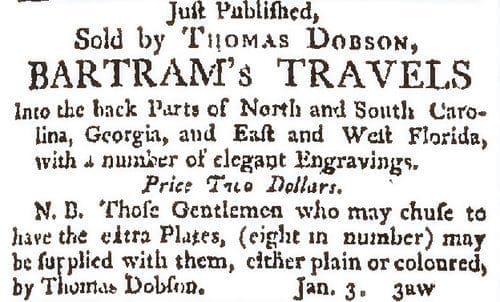
Travels as advertised in Dobson and Claypoole’s Daily Advertiser, January 4, 1792. (Image courtesy of Jim Green of the Library Company of Philadelphia
This is the equivalent of the $2.00 price for a bound copy of William Bartram’s Travels, but it isn’t known if Hamilton was a subscriber or if he purchased a retail copy in 1792. [Accounts were frequently paid long after the fact in the 18th century.]
So far no trace of this first Hamilton owned copy of Bartram’s Travels has surfaced. A second, fine copy of Travels, with the standard plates colored, and bound with the 8 extra plates colored was presented by William Bartram to William Hamilton in 1799. This presentation copy from 1799 is now owned by the Sterling Morton Library at the Morton Arboretum, Lisle, IL.
The Hamilton extra-illustrated copy of Travels, contains a rare copy of William Hamilton’s bookplate under the front cover, engraved with the Hamilton family arms and “W. Hamilton.” William Hamilton was certainly a collector of books, as well as plants, art, statuary and more. Recent research by Villanova students turned up a dozen volumes in Philadelphia area special collections libraries with the Hamilton bookplate or signature. But Hamilton likely owned dozens or even hundreds of volumes on botany, gardening and natural history. One book signed and with the W. Hamilton bookplate is now part of a collection of Bartram family books donated to the Historical Society of Pennsylvania in the 1890s by a Bartram descendant. That book. Thomas Martyn, The language of botany…, London: 1796 is a standard dictionary of botanic terms in English. It was probably loaned to William Bartram or another Bartram family member and never returned to Hamilton.

William Hamilton’s bookplate, engraved with the Hamilton family arms and “W. Hamilton,” graces the inside cover of the copy of Travels held at Morton Arboretum. (Image courtesy of the Sterling Morton Library)
The title page is signed by Hamilton on the upper right; “W. Hamilton’s Book give to him by the Author, June 9th, 1799.” No other documentation about this gift from William Bartram to William Hamilton survives. It may be Hamilton had lost or loaned his original copy of Travels, or he may have wanted an additional copy with the rare extra engraved plates?
It is clear that William Hamilton closely read this copy of Travels, as there are small annotations on several pages – including the addition of the scientific names “Gordonia Franklini” and “Pinckneya” on page 16, where the description of Franklinia was printed facing the two folded extra-illustrations of “Franklinia alatamaha” and “Bignonia bracteata” [modern Pinckneya bracteata, or fevertree].
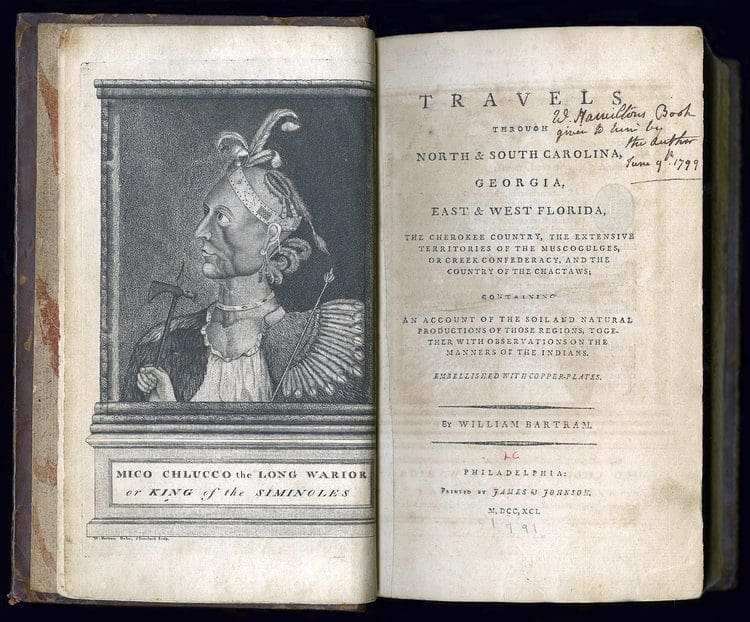
“W. Hamilton’s Book given to him by the Author June 9th, 1799” is inscribed on the cover page. (Image courtesy of the Sterling Morton Library)
Other notes by Hamilton in his extra-illustrated copy of Travels also comment or annotate some of the rarest plants that William Bartram encountered in his trip. And of course there is evidence that Hamilton was growing some of William Bartram’s southern plant discoveries in the garden at The Woodlands. One of the seed packets recently recovered from the attic of The Woodlands was labeled “Hydrangea quercifolia, Bartram’s Travels” and oakleaf hydrangea was another new plant described and illustrated by Bartram in the book.

Hamilton’s note of the scientific name “Gordonia Franklini” for Franklinia references part of a rare illustrated collection of new plants from Paris, published by the botanist Charles Louis L’Héritier de Brutelle in 1791. And the genus name Pinckney was not published as a scientific name until 1803 by the French botanist André Michaux. Hamilton may have learned of both these then current scientific names from Michaux’s Flora. Note the Franklinia plate folded to the right (as shown in the image above). (Image courtesy of the Sterling Morton Library)
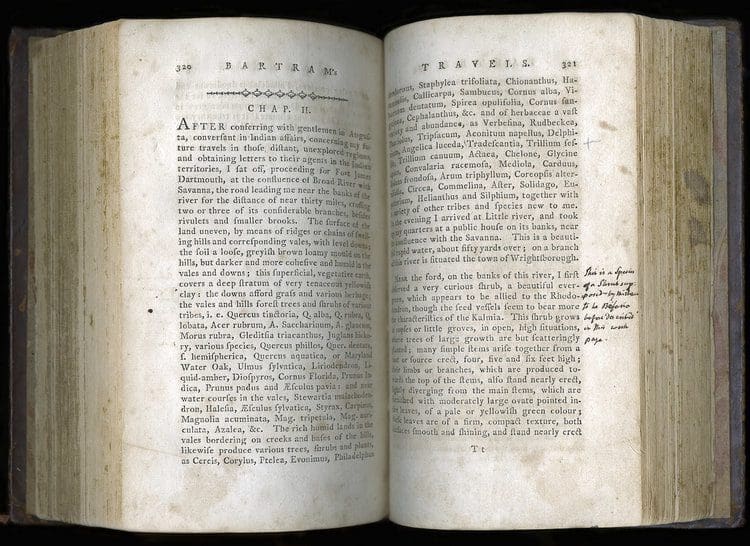
A note by Hamilton reads, ““This is a Species of a Shrub supposed by Michaux to be Befaria before described in this work page —.” Interestingly, this plant has gone through three spellings, “Befaria”, “Besaria”, and “Bejaria”. It is now officially called Bejaria racemosa, flyweed, a flowering shrub from Florida discovered by William Bartram. Flyweed as “Befaria hirsuta” was listed for sale as a greenhouse plant in Bartram Catalogues from 1807 onward. (Image courtesy of the Sterling Morton Library)
Hamilton’s inscriptions are telling; he only made notations in the botanic sections of Travels, indicating little interest in sections dealing with birds and wildlife, or in the parts dealing with Native peoples — the Creek, Seminole, and Cherokee.

“Errata” inserted at rear of William Bartram’s Travels… Phila: 1791, extra illustrated copy given to William Hamilton of The Woodlands, June 9th, 1799.
The Morton Arboretum, Lisle, IL. Photocopy and notes from Dr. Michael T> Stieber, Administravie and Reference Librarian
A group of scholars, including Nancy Hoffmann, Bill Cahill, Alina Josan and Joel Fry, are currently working to research and locate copies of the 1791 edition of William Bartram’s Travels, collating a census of copies, and looking for owner’s names, annotations, binding, and general history. The researchers have located over 125 copies, mainly in special collections libraries in the US, and have visited 56 or more copies. Many or most of the copies seem to be subscription copies, and a third or more have a similar original binding. Many of the owners who signed copies were substantial citizens in the early U.S, and local lending libraries around Philadelphia also held a number of copies. Only four are now know bound with the extra plates seen in William Hamilton’s copy at the Morton Arboretum. As of yet, the researchers don’t have a firm knowledge of how many copies of the 1791 Philadelphia edition were printed, but they estimate that it might be on the order of 400 or 500 total.
The lasting fame of Travels is probably due to the widespread European reprints of the book, which began to appear in 1792, a year after the Philadelphia printing. There were English editions of Travels in London in 1792 and 1794, Dublin: 1793; translations into German with editions in Berlin and Vienna: 1793; a Dutch translated edition in Haarlem, 1794-1797; and French translated editions from Paris: 1799 and 1801. These European editions were all based on the 1791 subscription version and copied the standard illustrations, but never included the 8 extra plates.
Stay tuned as we highlight more of the fascinating botanical connections between these two sites!
Previous Posts:
Introducing the Two Williams
Found in the Floorboards: 200 Year Old Seed Packets
Upcoming Posts:
Think Local Swap Global: 18th Century Approaches to Plant Collecting
From Seed Shack to Plant Palace: Evolutions in Greenhouse Technologies
The 19th Century Commercial Nursery


